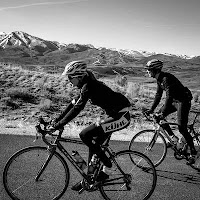This week we are going to talk about the importance of upper body strength, especially when climbing out of the saddle and sprinting
As cyclists we need to have STRONG upper bodies, however we need to limit MASS
Mass translates to extra weight and when we head uphill, weight is our enemy.
The key is to gain the strength slowly and my favourite way to do this are PUSHUPS military style
This exercise doesn't add much bulk, however it strengthens your arms, chest, shoulders, back and torso. During your rides you will spend almost all of your time in a position that is very similar to a push up position. (compare the images below)
For you ladies out there! Guess how Michelle Obama got and maintains those shapely strong arms of hers.
A correct military pushup starts with a straight back, similar to a plank. We need to hold our sacrum and back in the same plane and not allow our backs to either arch or sag. This will help us to hold the correct posture on the bike
As you lower yourself down, try not to go past 90 degs with your elbow bend. Any lower than that and it puts unnecessary strain on your elbows..
Start with 20 pushups if you can. If you can't do 20, then do as many as you can and then subtract 2, This will be your starting number of pushups for day one.
Now every day just add 1 pushup to the workout.
In 2 months if you started with 20 you will now be doing 80 pushups in one day.
Believe it or not that is over 560 pushups a week by week 8.
Do as many as you can in the first set to exhaustion of the muscles, then wait 1 min and complete the rest.
After only a few weeks you will notice a significant improvement on the bike. Your 2 hr workouts will feel like 90 min ones, your climbing will be more efficient with less fatigue and your sprinting will be faster
All in less than 2 mins a day
Great Cycling
Scott


